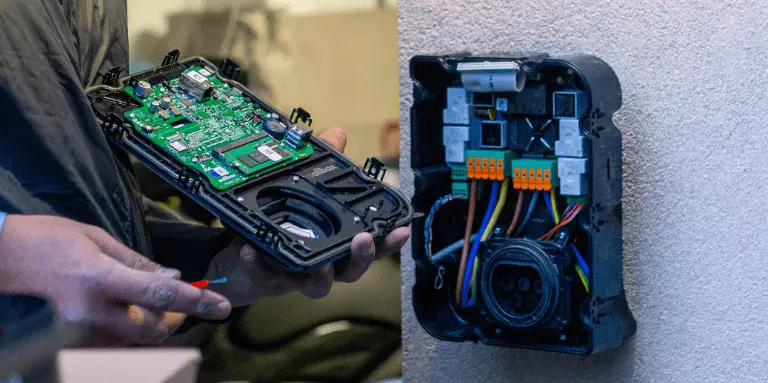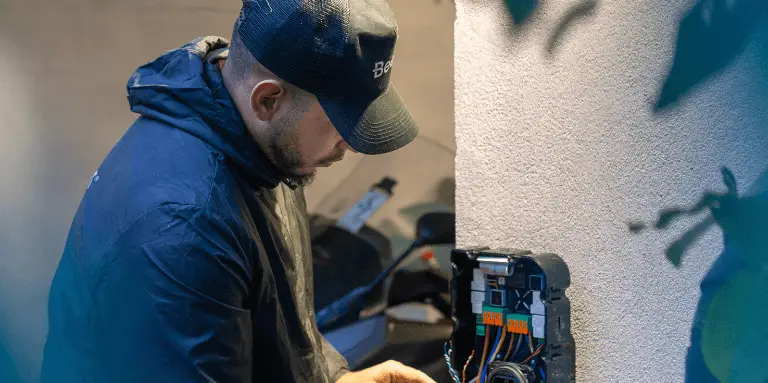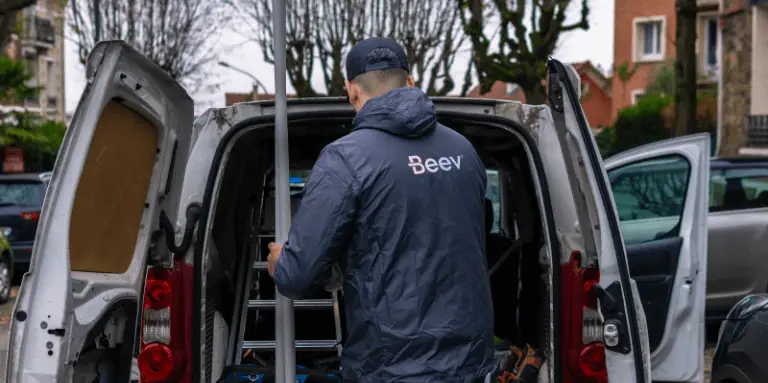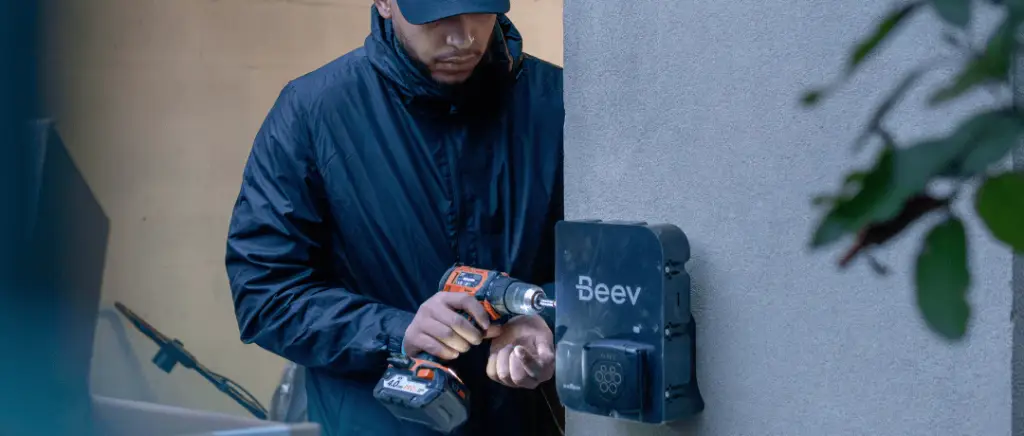your charging point
What are the mistakes to avoid when choosing a recharging solution?
Electric recharging points need special attention to ensure they work properly and last as long as possible. Avoiding certain mistakes can save you time and money while preserving the efficiency of your recharging solution.
Not maintaining your charging point
Daily maintenance of the recharging point remains essential to maintain its optimum performance.
Whether exposed to the elements or not, charging points can accumulate dust, dirt and even debris, obstructing connectors and reducing charging efficiency. Frequent cleaning with a clean, dry cloth removes the impurities, keeping the components in optimum working order.
N.B.: It is essential to clean the charging point on the surface only. Avoid wetting the connectors, using high-pressure jets or applying chemicals to clean your device.
Do not use an IRVE-certified installer
As stated above, it is imperative to use the services of a quality IRVE installer and to ensure that the installation complies with the NF C 15-100 standard.
In fact, faulty installation can lead to malfunctioning of the electrical bollard in just a few months. Poor quality electrical components such as cables and protective devices can suffer premature wear and tear. If the safety components fail, the bollard will be in a fault condition.


Neglecting your recharging point
Recharging electric vehicles is essential for vehicle owners, and neglecting your charging point can lead to costly problems.
First of all, you need to know that weather conditions represent the main reason for premature wear charging points.
Indoors, the recharging point is protected from the elements, reducing the need for maintenance. For outdoor installations, however, you need to select your equipment with care.
N.B.: Protection (IP) and resistance (IK) ratings vary depending on the charging station. For outdoor installation, we recommend an IP 54 rating. Without it, there is a risk of water penetrating the casing, leading to condensation that can corrode electronic components.
In a second phase, using a poor quality charging cable can lead to false contacts at the socket for a type 2 cable. Over time, this can lead to a deterioration in the quality of the connection at this point.
What's more, it's important to install a charging point in a collision-free area to reduce the risk of wear and tear.
Ignore updates
Software updates for charging stations, issued regularly by manufacturers, are designed to optimise performance and ensure perfect compatibility with the latest electric vehicle models.
So make sure you follow the manufacturer's instructions to the letter to keep your charging point software constantly up to date. By doing so, you ensure an optimal charging experience and maximum compatibility with your electric vehicle.
What is a maintenance contract?
Managers of corporate charging points would do well to give serious consideration to a maintenance contract. Whether you're a individual concerned about the condition of their home terminal or a professional looking to maximise the efficiency of its recharging equipment, a maintenance contract is a wise investment.
With this type of contract, the policyholder benefits from priority care in relation to other files. In this way, it avoids a long wait to refurbish its bollard and can quickly reuse it.
What's more, all breakdown costs are already partially or fully covered, including the cost of parts, labour and travel by IRVE technicians.
N.B.: An IRVE-approved technician is an electrician specialising in the installation of charging stations for electric vehicles. In compliance with the NF C 15-100 electrical standard, their expertise and skills ensure the safe installation of this device.
If you didn't know, since the decree of 12 January 2017, the installation of a recharging solution with a power equal to or greater than 3.7 kW must be carried out by a qualified electrician displaying the IRVE (Recharging Infrastructure de Véhicule Électrique). This certification attests to the electrician's training in the specific field of installing charging stations for electric vehicles.
Unfortunately, the maintenance of your charging point is limited. Indeed, the only thing you can do is clean the outside with a clean cloth. It's crucial to note that this cleaning must focus exclusively on the external surface, as this could lead to potential damage if you open the device.
N.B: The requirements of the decree of 12 January 2017, imposing at least one annual inspection of the various infrastructures, must be complied with by maintenance operators. The frequency of inspections may vary depending on the operator, the terms of the maintenance contract and the length of time the vehicle fleet is in use.
So you need to call in a professional. To be more precise, we have two types of maintenance.
Preventive or early maintenance
La preventive maintenance aims to anticipate failures/breakdowns of the appliance due to its components, by means of a maintenance routine. This enables action to be taken to avoid costly repairs. This type of maintenance is carried out at regular intervals.
During this service, the technician inspects the charging point and carries out the following operations:
- Test the various components to check that they are in good working order,
- Examine the connections and the condition of the cables,
- Examine the protection and control devices,
- Replace unsatisfactory parts,
- Check that there are no traces of moisture in the casing,
- Replace the filters,
- Clean the appliance thoroughly outside,
- Check that there are no foreign objects inside the equipment,
- Remove dust from the electronic board and components,
- Measure the earth value and the neutral/earth voltage,
- Run a firmware test.
It is important to differentiate between preventive/anticipated maintenance and predictive maintenance. These two terms should not be confused. The preventive maintenance follows a pre-planned scheduleas mentioned above.
On the other hand, the bollard can sometimes detect anomalies or risks of anomalies on its own, making repairs quicker, more efficient and more practical.
This is known as predictive maintenance. It is based on real-time data on the status and performance of your recharging equipment. In fact, some connected models offer the option of remote maintenance.


Curative maintenance
La remedial maintenance intervenes when the equipment has broken down and cannot be repaired. In this situation, the IRVE technician's task is to analyse the anomalies responsible for the breakdown in order to remedy them. The aim is to return a recharging point in perfect working order.
To carry out this task, he can replace an electronic board or filters on site, change a damaged or worn part, reconfigure a firmware, etc. He must then reconfigure the system before reactivating the bollard. They then reconfigure the system before reactivating the terminal.
At BeevWhen you buy one or more charging points, we can offer preventive maintenance for your equipment. company fleet and curative depending on the charging point model chosen.
For private customers, our Beev Care offers you a 2-year hardware warranty against wear and tear, force majeure and human error, cover against vandalism and theft, as well as dedicated technical support.
Summary table of different types of maintenance
| Type of maintenance | Description | Benefits | Typical operations |
|---|---|---|---|
| Preventive | - Anticipating breakdowns - Regular scheduled interventions |
- Avoids costly repairs - Extends the life of equipment |
- Component testing - Examination of connectors and cables - Replacing worn parts - Complete cleaning - Firmware check |
| Predictive | - Based on real-time data - Automatic detection of anomalies |
- Faster, more efficient response - Optimising maintenance |
- Analysis of performance data - Remote maintenance possible |
| Curative | - Breakdown response - Repair or replacement of defective components |
- Restoring operation - Analysis of causes of breakdown |
- Replacement of electronic boards - Changing damaged parts - System reconfiguration |
Conclusion: is the maintenance contract an end in itself?
The importance of a maintenance contract for an electric charging point cannot be underestimated. Whether you're a professional managing a fleet of electric vehicles or an individual owning a home charging point, the peace of mind offered by a preventive maintenance contract is invaluable.
There is no obligation to have your charging point checked frequently by a professional, and many electric car users prefer not to do so. However, many electric car users prefer not to, a maintenance contract can be advantageous for cautious individuals seeking to minimise risk and ensure rapid intervention in the event of a problem.
What's more, most companies specialising in the maintenance of recharging stations are quick to help their customers if the charging point is unavailable, which has an impact on the use of electric vehicles.
At Beev, our experts can help you with your charging point project, whether for your home or your business fleet. Don't hesitate to contact us !
If you would like to find out more aboutsupport for the installation of charging points for businesses in 2024For more information, see our article on this subject.
You want to order your Beev recharge card ?
Thanks to our card,recharge your electric car with ease at all the charging points available in Europe.
































